
Detail of A Map of the most Inhabited part of Virginia containing the whole Province of Maryland with Part of Pensilvania, New Jersey and North Carolina. Black-and-white line engraving with period color. H. 31 3/8", W. 49 1/8". Joshua Fry and Peter Jefferson, cartographers. Thomas Jefferys, map engraver. London, 1768. (Courtesy, Colonial Williamsburg Foundation.) Fredericksburg and Falmouth are illustrated on either side of the Rappahannock River.

Candle stand attributed to James Allan, Fredericksburg, Virginia, 1759. Mahogany. H. 48", W. 10" (top). (Courtesy, George Washington’s Mount Vernon; photo, Gavin Ashworth.) The gallery of the stand is triple laminated for resilience and strength. This is an urban British detail rarely encountered on colonial American furniture.

Detail of the carving on the candle stand illustrated in fig. 2. (Photo, Gavin Ashworth.)
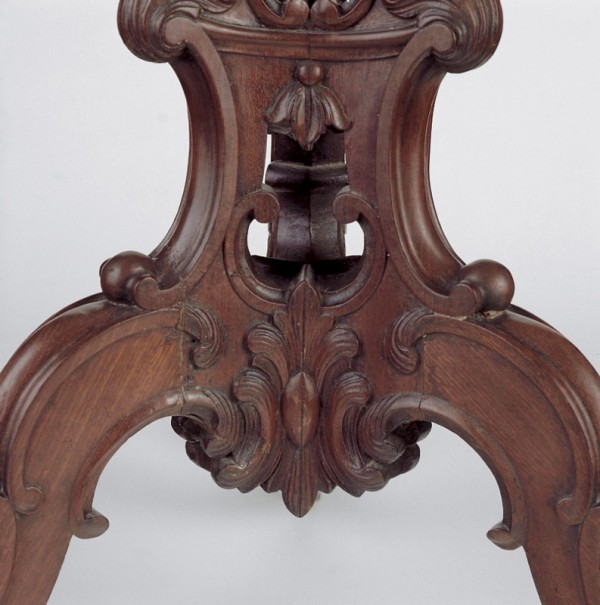
Detail showing the construction and carving of the base of the candle stand illustrated in fig. 2. (Photo, Gavin Ashworth.)
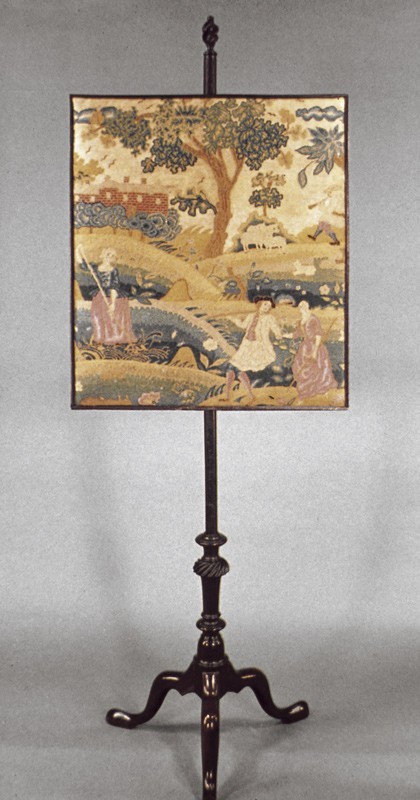
Fire screen, London, England, ca. 1759. Mahogany. H. 57", W. 18 3/4", D. 17 1/8". (Courtesy, George Washington’s Mount Vernon.) The pair of fire screens that George Washington purchased from London cabinetmaker Philip Bell in 1759 cost eight shillings less than the pair of stands Washington bought from James Allan.
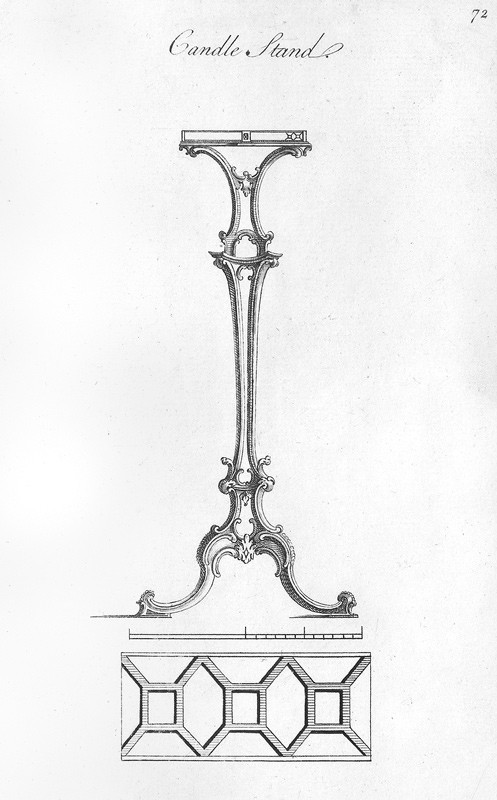
Design for a candle stand illustrated on plate 72 in London Society of Upholsterers, Genteel Household Furniture (London, ca. 1760). (Courtesy, Winterthur Library, Printed Book and Periodical Collection.)
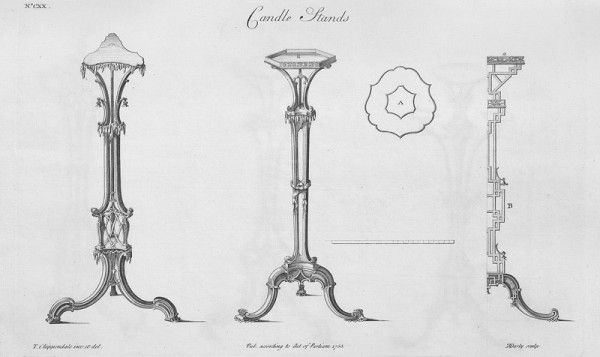
Designs for candle stands illustrated on plate 122 in Thomas Chippendale, Gentleman and Cabinet-Maker’s Director (London, 1754). (Courtesy, Winterthur Library, Printed Book and Periodical Collection.) The date on this engraved plate is 1753.

Side chair possibly by James Allan, Fredericksburg, Virginia, 1765–1775. Black walnut with yellow pine. H. 38 7/16", W. 19 7/8", D. 19 3/4". (Private collection; photo, Colonial Williamsburg Foundation.)
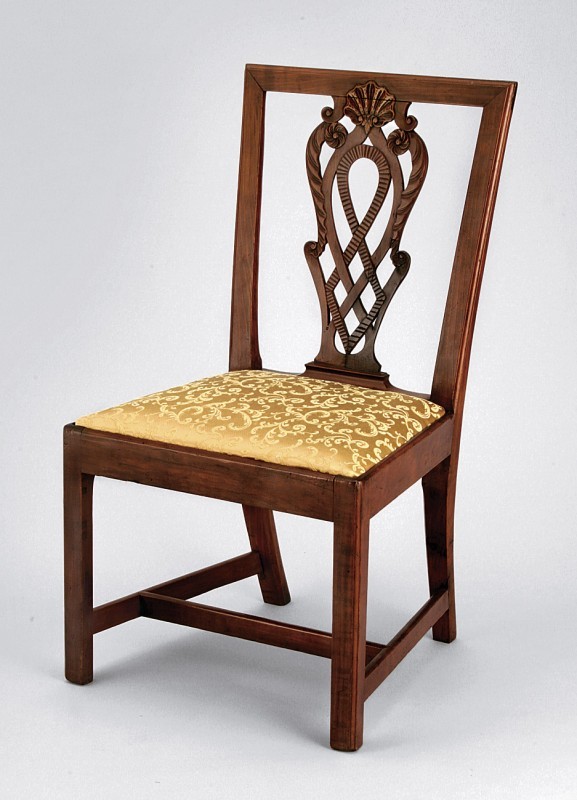
Side chair possibly by James Allan, Fredericksburg, Virginia, 1765–1780. Cherry with yellow pine. H. 36 3/8", W. 20 1/2", D. 20 3/8". (Courtesy, Colonial Williamsburg Foundation, gift of Mr. and Mrs. David Peebles in honor of Ronald L. Hurst.) This chair is almost identical to the Magruder family chair not illustrated. The shell at the top of the splat on the Magruder chair is inverted.

Side chair possibly by James Allan, Fredericksburg, Virginia, 1765–1775. Black walnut. H. 35 5/8", W. 20", D. 18 1/2". (Courtesy, Colonial Williamsburg Foundation.)
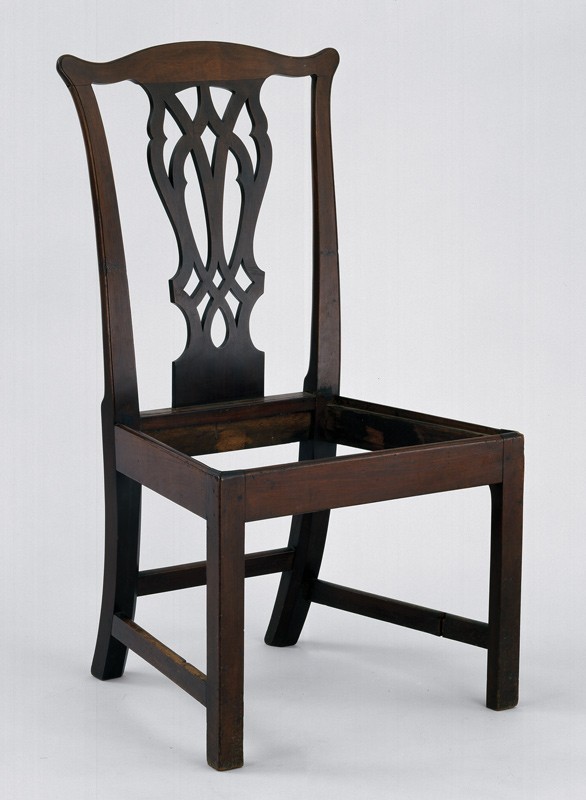
Side chair possibly by James Allan, Fredericksburg, Virginia, 1770–1775. Mahogany. H. 38 1/2", W. 19 5/8", D. 19 5/8". (Courtesy, Colonial Williamsburg Foundation, gift of Mrs. A. D. Williams.) The splat is replaced.

Side chair possibly by James Allan, Fredericksburg, Virginia, 1765–1775. Mahogany with ash. H. 37 5/8", W. 22", D. 16 3/8". (Courtesy, Museum of Early Southern Decorative Arts, Old Salem Museums & Gardens.)
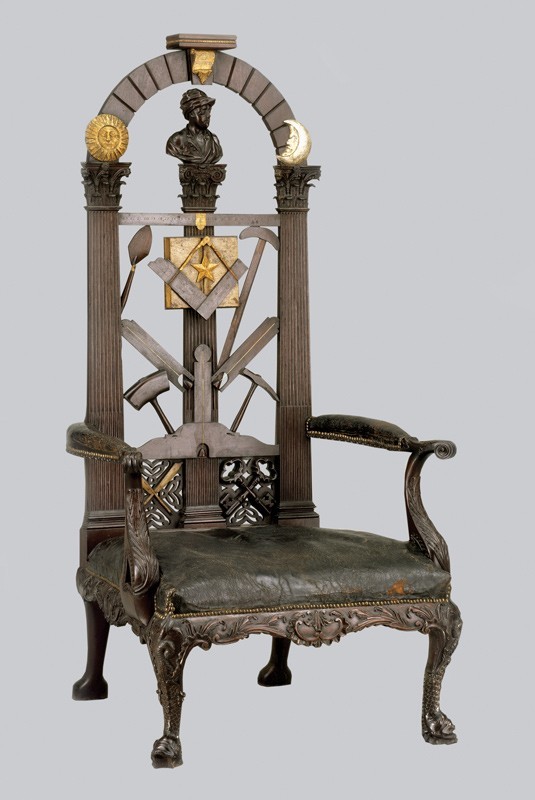
Benjamin Bucktrout, armchair, Williamsburg, Virginia, 1766–1777. Mahogany and black walnut. H. 65 1/2", W. 31 1/4", D. 29 1/2". (Courtesy, Colonial Williamsburg Foundation.) For more on this chair, see F. Cary Howlett, “Admitted to the Mysteries: The Benjamin Bucktrout Masonic Master’s Chair,” in American Furniture, edited by Luke Beckerdite (Hanover, N.H.: University Press of New England for the Chipstone Foundation, 1996), pp. 195–232.

Armchair attributed to the Anthony Hay Shop, Williamsburg, Virginia, ca. 1765. Mahogany. H. 52 1/2", W. 29 1/2", D. 26 1/4". (Courtesy, Williamsburg Masonic Lodge.) This armchair was probably made for the master of Williamsburg Masonic Lodge No. 6.
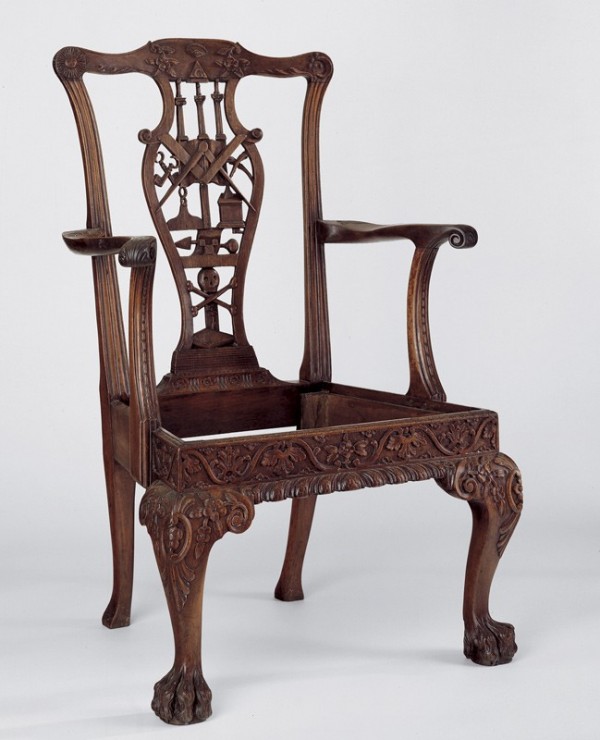
Armchair attributed to Thomas Miller, Fredericksburg, Virginia, 1773–1774. Mahogany with walnut and oak. H. 42 1/2", W. 27 1/2", D. 18 7/8". (Courtesy, Fredericksburg Masonic Lodge No. 4, A. F. & A. M.; photo, Gavin Ashworth.) This armchair was probably made for the master of Fredericksburg Masonic Lodge No. 4. The Grand Lodge of Scotland chartered the Fredericksburg lodge.

Armchair, probably Falmouth, Virginia, 1773–1785. Mahogany and walnut with yellow pine. H. 43", W. 28 3/4", D. 18 7/8". (Courtesy, Fredericksburg Masonic Lodge No. 4, A. F. & A. M.; photo, Gavin Ashworth.) This armchair was probably made for the Falmouth Masonic lodge.
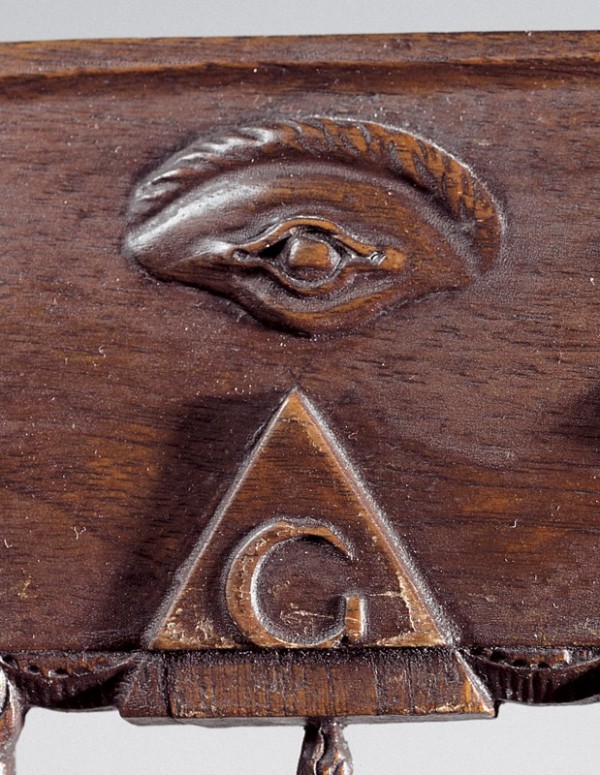
Detail of the eye on the crest of the armchair illustrated in fig. 15. (Photo, Gavin Ashworth.) The carving on this armchair is superior to that on the example illustrated in figs. 16 and 19. The eye on the Lodge No. 4 chair is naturalistic with subtle modeling of the eyelids and eyebrow.

Detail of the back of the armchair illustrated in fig. 15. (Photo, Gavin Ashworth.)

Detail of the back of the armchair illustrated in fig. 16. (Photo, Gavin Ashworth.)

Fredericksburg Masonic Lodge No. 4 Record Book, March 3, 1753. (Courtesy, Fredericksburg Masonic Lodge No. 4, A. F. & A. M.; photo, Gavin Ashworth.)

Fredericksburg Masonic Lodge No. 4 Record Book, 1773–1774. (Courtesy, Fredericksburg Masonic Lodge No. 4, A. F. & A. M.; photo, Gavin Ashworth.)
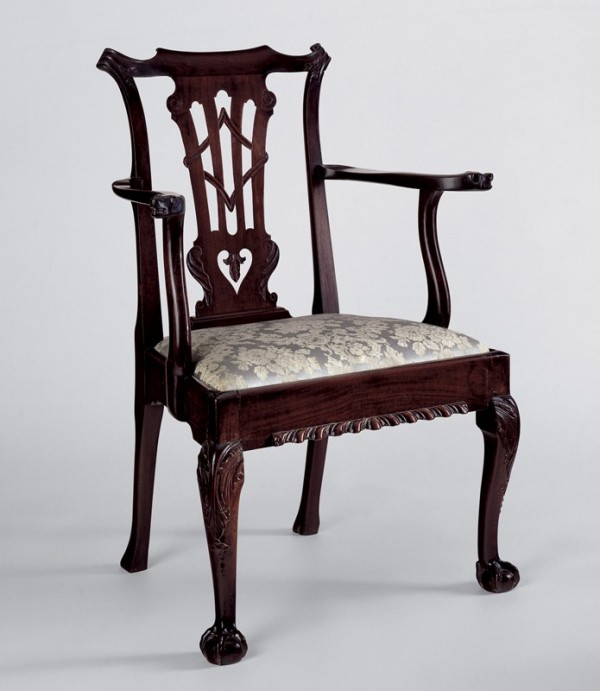
Armchair attributed to Robert Walker, King George County, Virginia, ca. 1749. Mahogany. H. 38 1/2", W. 28 1/2", D. 18". (Courtesy, Mary Washington House of the Association for the Preservation of Virginia Antiquities; photo, Gavin Ashworth.)
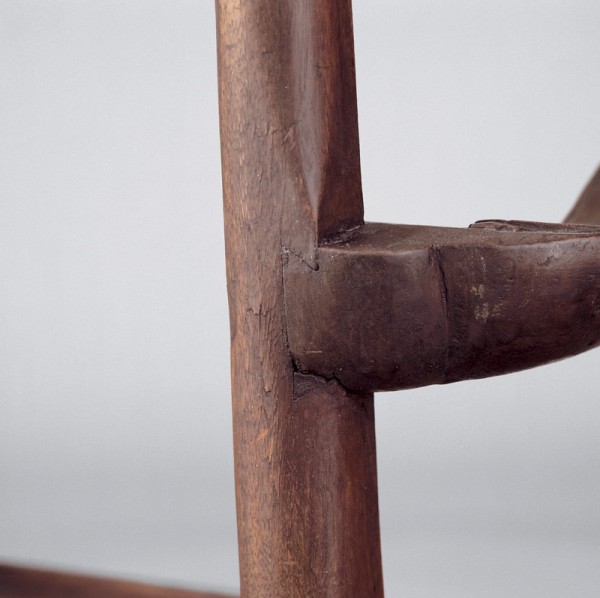
Detail of the dovetail used to join the left arm and rear stile of the armchair illustrated in fig. 15. (Photo, Gavin Ashworth.)

Detail of the quarter-round, two-part vertical glue block behind the right front knee of the armchair illustrated in fig. 15. (Photo, Gavin Ashworth.)
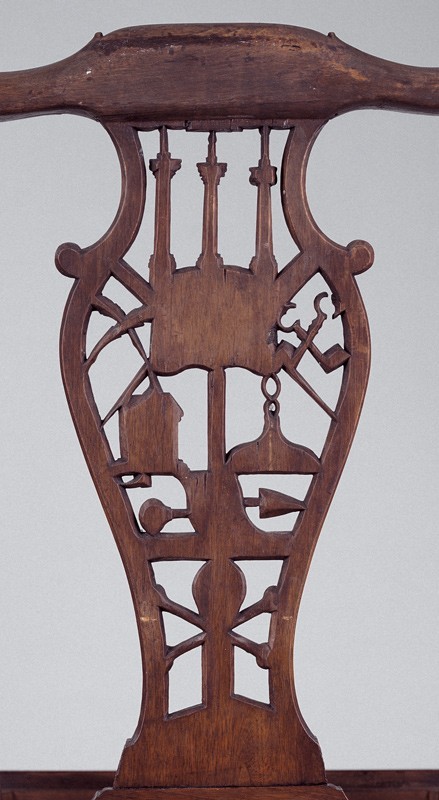
Detail of the chamfering on the splat of the armchair illustrated in fig. 15. (Photo, Gavin Ashworth.)
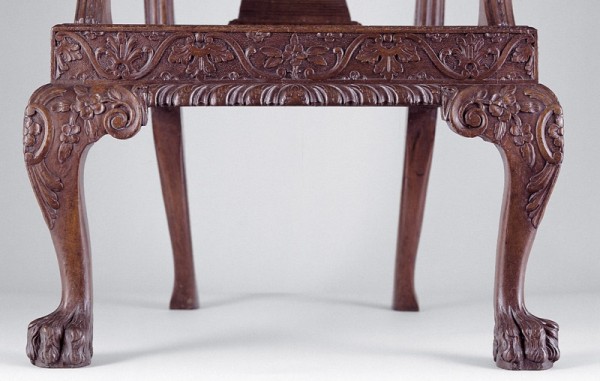
Detail of the front seat rail of the armchair illustrated in fig. 15. (Photo, Gavin Ashworth.) The gadrooned molding and knee blocks are attached to the face of the rail.
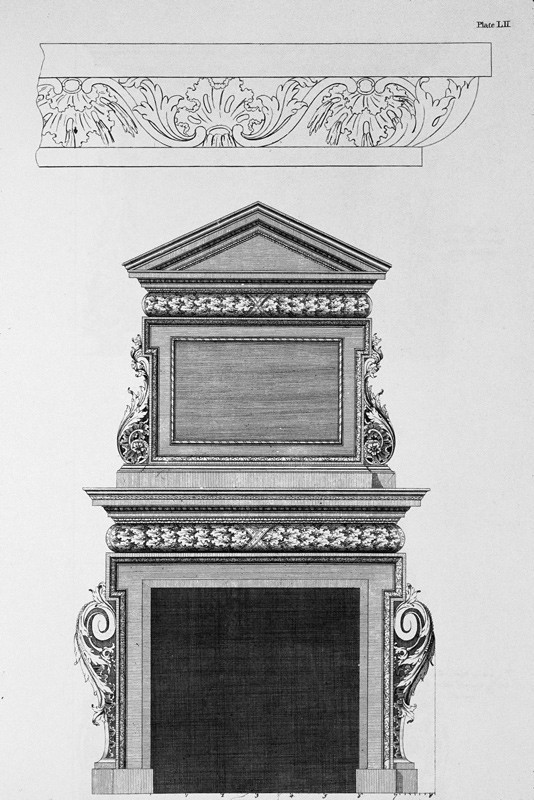
Design for a frieze illustrated in Abraham Swan, The British Architect (London, 1758), pl. 52. (Courtesy, Colonial Williamsburg Foundation.) This plate first appeared in the 1745 edition.
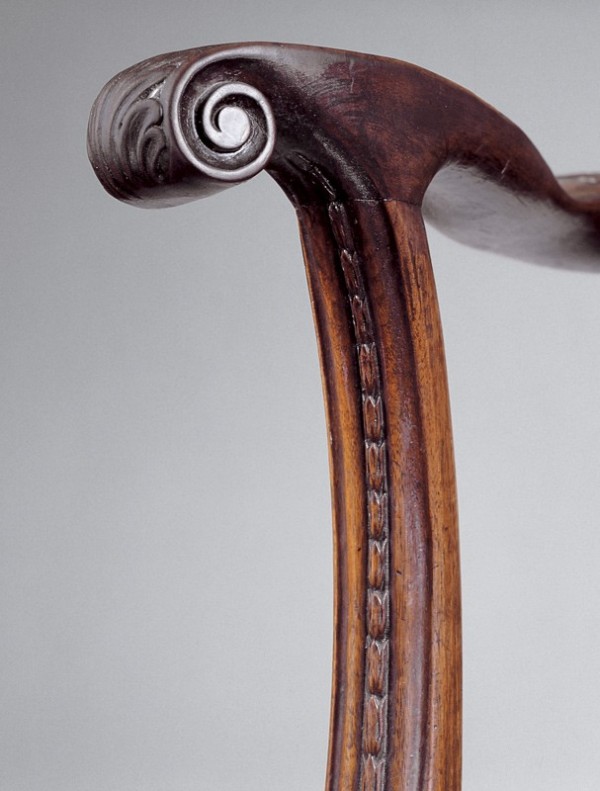
Detail of the carved husks on the left arm support of the armchair illustrated in fig. 15. (Photo, Gavin Ashworth.)

Detail of the shoe of the armchair illustrated in fig. 15. (Photo, Gavin Ashworth.) The flutes represent triglyphs and the rosettes represent metope flowers.
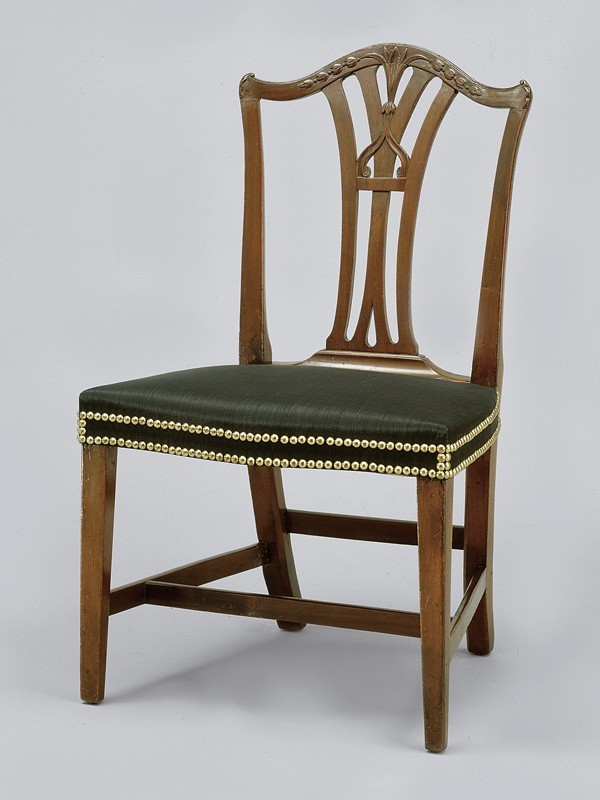
Side chair attributed to William Fenton, London, ca. 1768. Mahogany with beech. H. 36 1/8", W. 19 7/8", D. 18 1/4". (Courtesy, Colonial Williamsburg Foundation.)
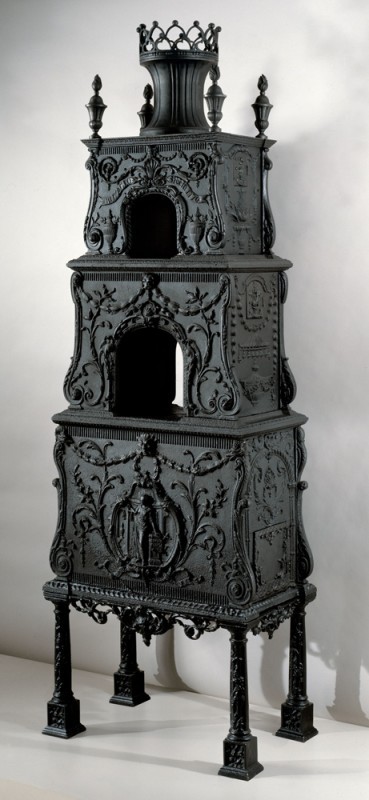
Stove designed by Abraham Buzaglo, London, 1770. Cast iron. H. 89", W. 35 1/8", D. 21 11/16". (Courtesy, Commonwealth of Virginia; on loan to Colonial Williamsburg Foundation.)

Thomas Chippendale, armchair, after a design by Robert Adam, London, 1765. Mahogany with unidentified secondary woods. H. 41 3/4", W. 30 3/8", D. 30 3/8". (© V&A Images/Victoria and Albert Museum, London, www.vam.ac.uk.) Chippendale made this chair for Sir Lawrence Dundance of London and Aske Hall. Like the Lodge No. 4 armchair, this example has both George II and early neoclassical details.
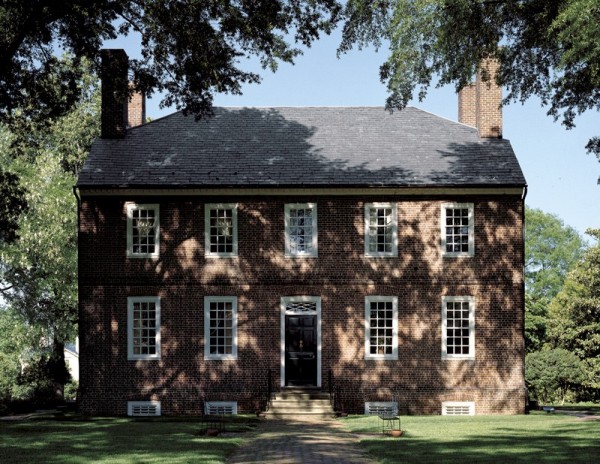
Kenmore, Fredericksburg, Virginia, 1772–1775. (Courtesy, George Washington’s Fredericksburg Foundation; photo, Gavin Ashworth.)
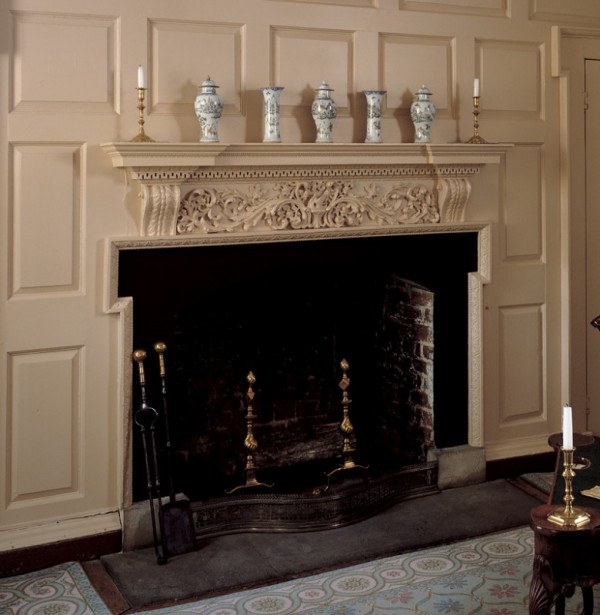
Chimneypiece in the first-floor chamber in Kenmore. (Photo, Gavin Ashworth.) The architectural carving in Kenmore was probably installed near the end of construction in 1774 or 1775.

Chimneypiece in the Chimneys, Fredericksburg, Virginia, 1775–1780. (Courtesy, Eileen’s at the Chimneys; photo, Gavin Ashworth.)

Detail of a five-petal flower on the appliqué of the chimneypiece illustrated in fig. 34. (Photo, Gavin Ashworth.)
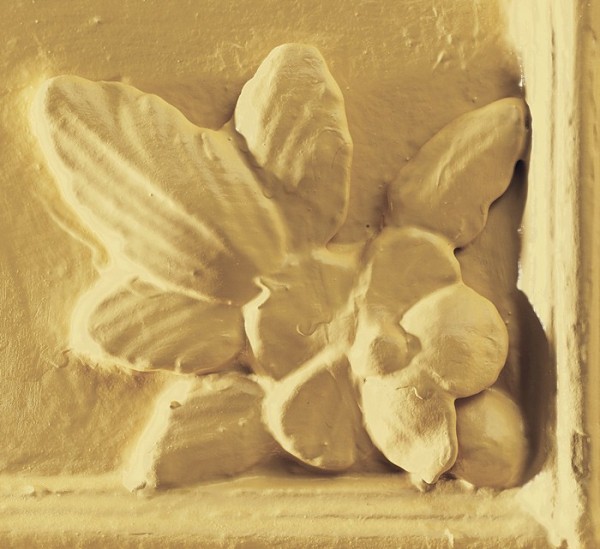
Detail of a five-petal flower and leaf appliqué on the chimneypiece illustrated in fig. 35. (Photo, Gavin Ashworth.)

Detail of a five-petal flower carved in relief on the front seat rail of the armchair illustrated in fig. 15. (Photo, Gavin Ashworth.)
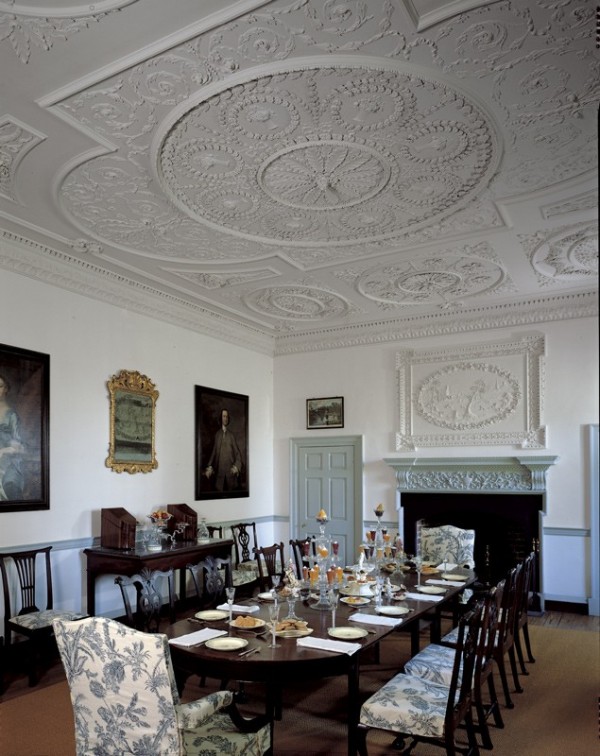
Large dining room in Kenmore. (Photo, Gavin Ashworth.) This chimneypiece has neoclassical features not found on other carving in Kenmore.

Armchair attributed to Thomas Miller, Fredericksburg, Virginia, ca. 1774. Cherry with oak. H. 38 1/2", W. 26 1/2", D. 21 1/2". (Private collection; photo, Colonial Williamsburg Foundation.)
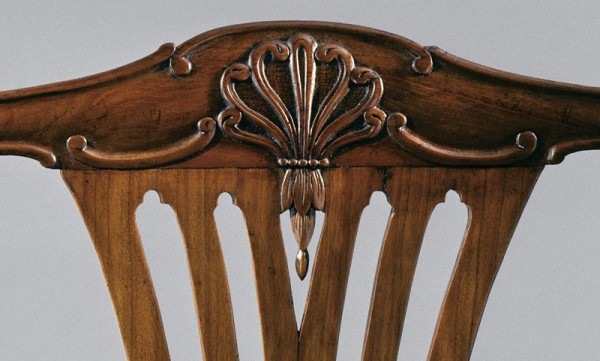
Detail of the carved anthemion on the crest rail of a side chair from a set that included the armchair illustrated in fig. 40. (Courtesy, Colonial Williamsburg Foundation.)

Detail of the carved anthemions and husks on the left truss of the chimneypiece illustrated in fig. 39. (Photo, Gavin Ashworth.)
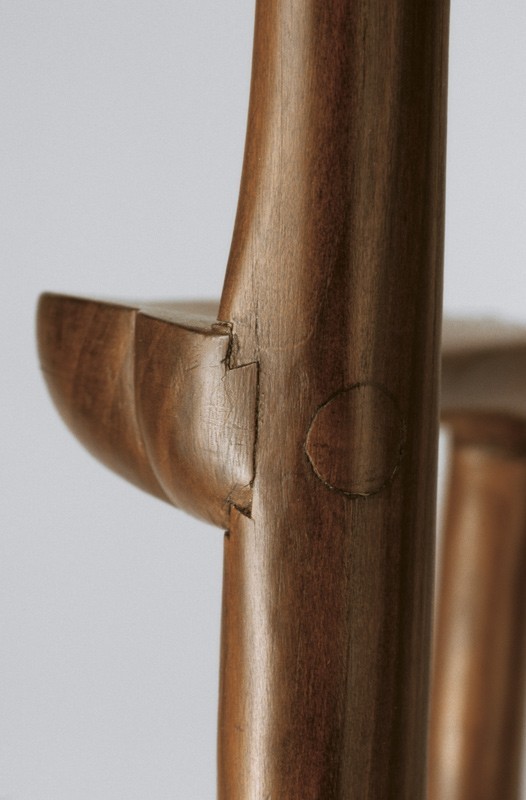
Detail of the dovetail used to join the right arm and rear stile of the armchair illustrated in fig. 40.
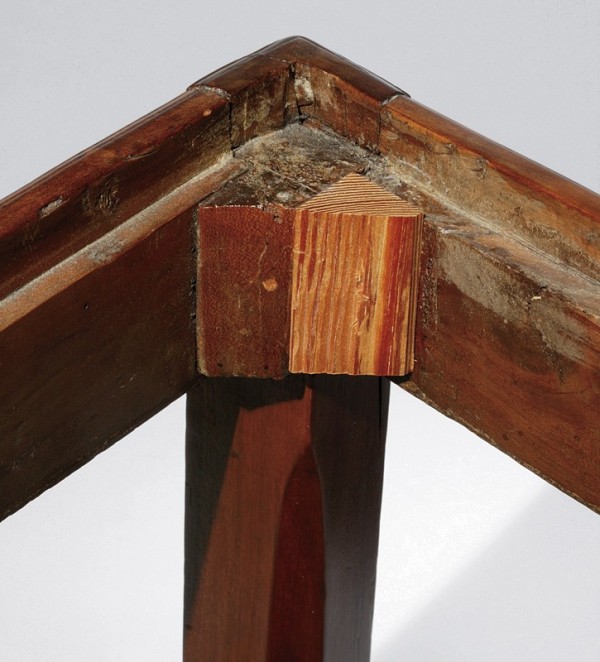
Detail of the two-part vertical glue block reinforcing the left front leg and rail joints of the armchair illustrated in fig. 40. One laminate of the glue block is a replacement.

Photograph of the Old Lodge Room, Fredericksburg Masonic Lodge No. 4, Fredericksburg, Virginia, ca. 1930. (Courtesy, Fredericksburg Masonic Lodge No. 4, A. F. & A. M.)

Side chair attributed to Thomas Miller, Fredericksburg, Virginia, ca. 1774. Mahogany with oak. H. 37 1/2", W. 21 1/2", D. 19 1/2". (Courtesy, Colonial Williamsburg Foundation.)
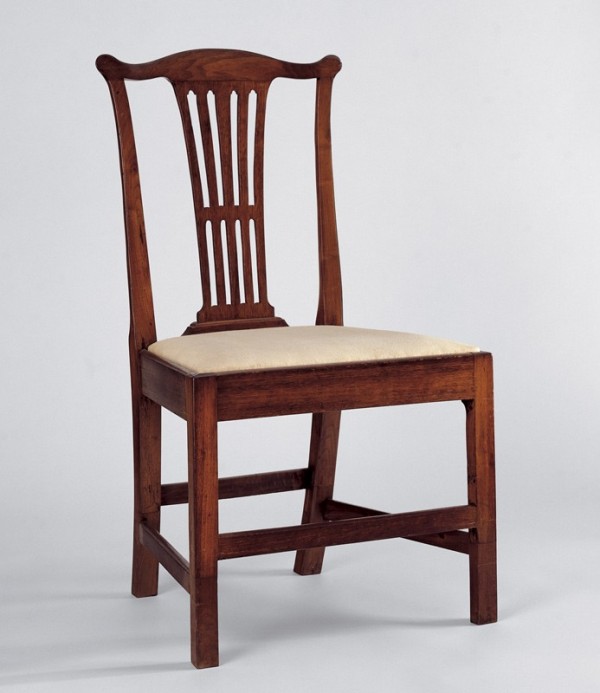
Side chair attributed to Thomas Miller, Fredericksburg, Virginia, 1769–1774. Black walnut. H. 37 1/2", W. 21 1/4", D. 19 1/4". (Courtesy, Fredericksburg Area Museum and Cultural Center, gift of Genevieve Rowe Hunter; photo, Gavin Ashworth.)
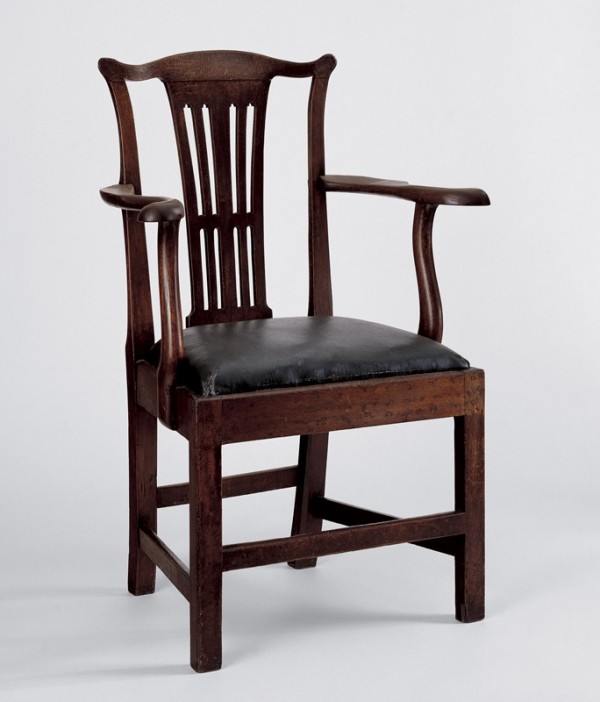
Armchair attributed to Thomas Miller, Fredericksburg, Virginia, 1769–1774. Mahogany with oak. H. 39 1/2", W. 26 1/2", D. 17 7/8". (Courtesy, Fredericksburg Masonic Lodge No. 4, A. F. & A. M.; photo, Gavin Ashworth.)

Tall clock case attributed to James Allan with movement by Thomas Walker, Fredericksburg, Virginia, 1765–1785. Mahogany with yellow pine, tulip poplar, oak, and cherry. H. 106 1/4", W. 22", D. 10 1/2". (Courtesy, Museum of Fine Arts, Boston, M. and M. Karolik Collection,© 2006 Museum of Fine Arts, Boston.) Carved pagodas like the example on the hood of this clock occur in the same context on British cases as well as those made west of Fredericksburg.
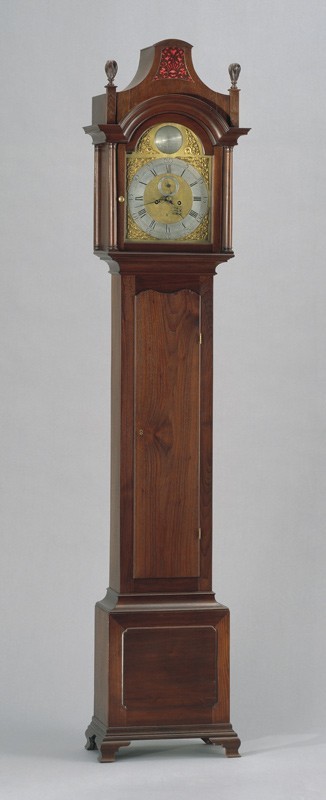
Tall clock case attributed to James Allan with movement by Thomas Walker, Fredericksburg, Virginia, 1765–1785. Black walnut with yellow pine. H. 97 1/4", W. 21 1/4", D. 9 1/2". (Courtesy, Colonial Williamsburg Foundation, gift of Jane C. Lanham and Shirley Lanham McCrary.)

Tall clock case attributed to James Allan with movement by Thomas Walker, Fredericksburg, Virginia, 1765–1785. Walnut with yellow pine and oak. H. 96 1/2", W. 20 7/8", D. 10 3/8". (Courtesy, Colonial Williamsburg Foundation, gift of Elizabeth M. Nicholson).
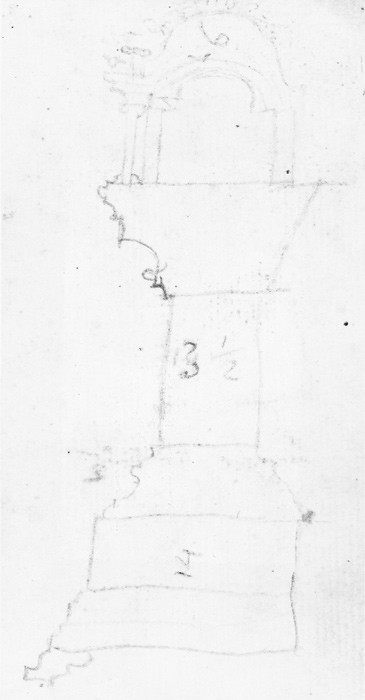
Sketch of a tall case clock in the account book of Robert Cockburn, Falmouth and Orange County, Virginia, 1767–1777. (Courtesy, Winterthur Library, Joseph Downs Collection of Manuscripts and Printed Ephemera.)

Tall clock case attributed to Robert Walker, Fredericksburg, Virginia, with movement by Goldsmith Chandlee, Winchester, Virginia, 1809–1811. Cherry, cherry veneer, and lightwood inlay with walnut and tulip poplar. H. 98 1/2", W. 27 7/8", D. 10 1/2". (Private collection; photo, Museum of Early Southern Decorative Arts, Old Salem Museums & Gardens). This clock descended in the Booth family of Westmoreland County, Virginia.

Side chair, Fredericksburg, Virginia, 1805–1815. Mahogany with ash and yellow pine. H. 36 1/2", W. 21 1/4", D. 18". (Courtesy, Colonial Williamsburg Foundation.)
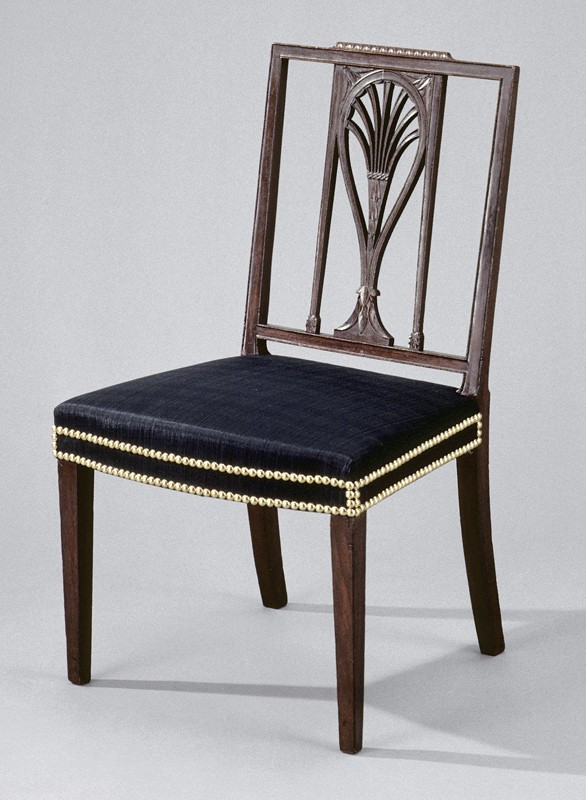
Side chair, Fredericksburg, Virginia, 1800–1815. Mahogany with black walnut and soft maple. H. 34 1/8", W. 19 1/2", D. 17 1/4". (Courtesy, Colonial Williamsburg Foundation.)

Armchair stamped “J. Beck,” Fredericksburg, Virginia, ca. 1805. Tulip poplar, hickory, and birch. H. 36", W. 20 3/4", D. 17 1/4". (Private collection; photo, Museum of Early Southern Decorative Arts, Old Salem Museums & Gardens.)

Lap desk attributed to James Beck, Fredericksburg, Virginia, ca. 1806. Mahogany with tulip poplar. H. 9", W. 15", D. 16". (Private collection; photo, Museum of Early Southern Decorative Arts, Old Salem Museums & Gardens.)
